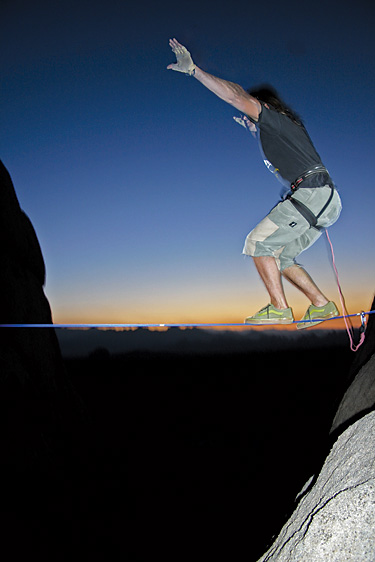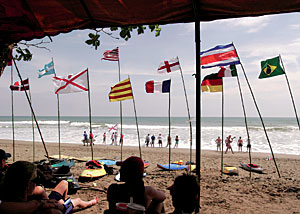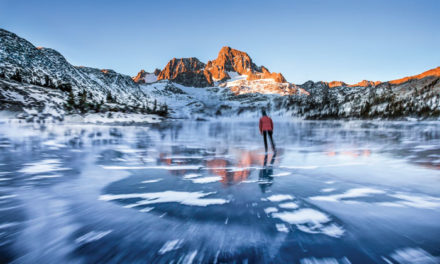- Tahoe’s Nevada Beach Tops the List of Hard-to-Book Campgrounds - 07/17/2024
- Cannabis Watershed Protection Program Cleans Up Illegal Grow Sites - 07/10/2024
- French Fire - 07/05/2024

Story by Seth Lightcap • Photos by Kevin Walker
Shawn Snyder, Indian Cave Corridor, Joshua tree
Slacklining, the art of walking along one-inch wide nylon webbing, is a new school variation of circus style tight-rope walking. Born along chain link fences in Yosemite Valley, the sport of slacklining has become a recreational phenomenon enjoyed worldwide, from the beaches to the highest alpine spires.
A slackline gets its name because although the line is tensioned very tightly between two anchor points, it is not rigidly taut due to the dynamic nature of the nylon webbing. As you walk out on the line the webbing stretches underfoot and hence it feels “slack” compared to a rigid tightrope cable that does not stretch. The squirrelly and seemingly unpredictable movement of the line is what makes slacklining the ultimate balance challenge. Your entire mind, body, and soul are needed just to stay blanaced, let alone walk
the line.
The average slackline is set up between trees or posts at a beach or park and ranges from 15 to 100 feet in length. The tension of the line varies based on your equipment and desire. A tight line is easier to walk, but the rubbery bounce of a slightly looser line can be rewarding. There is always a great deal of energy in the line so getting aggressively bucked off is not uncommon. To avoid injury, most slacklines are set up within a few feet of the ground.
While rope walking has been around for thousands of years, the familiar art of slacklining along a taut length of tubular nylon webbing was invented in the early 1980s by two Yosemite rock climbers, Adam Grosowsky and Jeff Ellington. The pair picked up on the idea after walking along loose chain fences on rainy days in the Valley. Hooked on the challenge, they strung up old climbing webbing between trees around their campsites at Camp 4, the traditional campground for Yosemite climbers for over 40 years. Voila! The slackline was born.
In the summer of 1983, Adam and Jeff’s slackline antics started to draw the attention of other Yosemite climbers. Their attempt at walking on a steel cable across the gap between the Valley rim and Lost Arrow Spire, a 2900-foot deep chasm that’s 55 feet across, was especially impressive. Several more climbers began slacklining that summer, but only a select few really developed a passion for it. One of the most inspired was a young climber named Scott Balcom.
Returning to Southern California that fall, Scott and a few friends started practicing religiously and experimented with different types of slacklines. Soon Scott’s skills were dialed and he began focusing on the goal inherited from Adam and Jeff – to walk across the Lost Arrow Spire gap. For practice, Scott’s crew set up a 22-foot slackline underneath a highway that spanned an 80-foot drop. Using doubled lines for added strength, and harnesses and a tether to escape from would-be fatal falls, this “highline” was a first of its kind.
In 1984, Scott returned to Yosemite set on conquering the Lost Arrow chasm. Skilled but unable to escape his fear, the exposure proved too daunting and Scott was unsuccessful. Throughout the next year Scott trained both harder and smarter, focusing on visualization and distance perception. The training paid off and that next summer, in July of 1985, Scott became the first person to walk the gap from Lost Arrow Spire to the Valley rim.
Scott’s achievement stands proud to this day. Still the most coveted accomplishment in the world of slacklining, the Lost Arrow highline was not walked again until 1993 when Darrin Carter successfully crossed the span. Darrin would later up the ante even further by not only crossing the span in both directions, but also by crossing without a safety tether!
Though Adam, Jeff, Scott and Darrin were the pioneers, it was not until well-known rock climber Dean Potter stepped on the Lost Arrow highline that slacklining was seen in the public eye. Pictures of Dean slacklining in Patagonia ads introduced the sport to the masses and inspired the next generation of slackliners such as Shawn Synder, Corbin Usinger, and Damian Cooksey.
In today’s world of slacklining, the discipline has evolved two distinct specialities – lowlining and highlining. Lowlining is the style that a majority of slackliners enjoy because it can be practiced anywhere you can find two anchors and requires a lot less equipment. With little consequence for falling, lowlines also afford the freedom to attempt tricks on the line. The progression of lowline stunts is much like that of a gymnast on a balance beam – beginners work on moving smoothly through direction changes while the very best in the world execute front and back flips (taking off and landing on the line). Freestyle slackline competitions are even popping up where competitors perform a routine for judges.
On a highline, overcoming your fear to just walk the span is the goal. Highlines are significantly more dangerous as swinging falls can careen you back into the rock and the rigging of the line must be incredibly strong to withstand a fall midline. The exposure on a highline is immense and only those who can focus beyond their trivial fears will be successful. Despite the danger, the world’s best slackliners and rock climbers continue to push the boundaries of balance by walking highlines as long as 200 feet.
Slacklining is a graceful form of moving meditation and many regard its benefits to be Zen like. “Walking the slackline makes you look within,” notes accomplished highliner Shawn Synder. “Everytime I walk a highline it’s almost like a beautiful enlightenment … an experience that opens your eyes, softens your heart, and quiets you a little bit.”
Though rock climbers have been the foremost proponents of slacklining, walking the line can be fantastic training for any sport requiring balance. Professional surfers, snowboarders, and cyclists have taken up slackline training as a means of improving core strength and mental resolve. Walking the quivering line mimics riding through uneven terrain and improves your ability to control your center of gravity and stick to your path no matter the obstacle.
Whether you’re an aspiring surfer, climber, or Cirque de Soleil performer, learning to walk on a slackline will undoubtedly improve your performance. Part sport, part meditation, slacklining requires focus and commitment. Look for a slackline in a neighborhood near you or learn how to make one. Better balance is just a couple of wobbly steps away!













